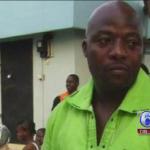Ebola and Witchcraft in Africa
A British doctor fighting the devastating Ebola outbreak in west Africa has told how belief in witchcraft is hampering the fight to stop the spread of the deadly disease.
Benjamin Black, 32, a volunteer with the charity Médecins Sans Frontières in Sierra Leone, said that some of those in infected areas were not seeking medical treatment as they thought the disease was the work of sorcerers. Belief in witchcraft and traditional medicine is still prevalent in parts of west Africa, particularly the remote rural areas of Sierra Leone, Guinea and Liberia where the outbreak has been concentrated.
In an interview with The Telegraph, Dr Black, who completed a four-day stint earlier this week at an Ebola treatment clinic in Kailahun, near Sierra Leone’s northern border with Guinea, said: “There is a section of population here who simply don’t believe Ebola is real, they think it is witchcraft and so they don’t come to the treatment centres.
“Sometimes, even those who turn up at clinics with symptoms of the disease will be resistant to the idea that they have it. They will say ‘yes, people in my family have died already, but this is witchcraft rather than Ebola’.”
Dr Black, who is from Manchester but currently works as an obstetrics & gynaecology registrar at north London’s Whittington Hospital, went to Sierra Leone back in June, where he originally expected to be working in maternity wards. He was seconded to an Ebola clinic in the wake of the spread of the epidemic, which is the largest of its kind in medical history.
More than 1,200 cases have so far been reported in the three affected nations, with 224 deaths in Sierra Leone, 129 in Liberia, and 319 in Guinea, where the outbreak is thought to have first begun. Among the fatalities in Sierra Leone has been Sheik Umar Khan, a doctor who was playing a leading part in the fight against the disease.
Avoiding a similar fate for themselves has been one of the main challenges for Dr Black and his colleagues in the 56-bed clinic at Kailahun, which lies in a densely-forested district that is at the centre of one of the worst outbreaks.
While treating patients, medics must wear an all-encompassing plastic yellow body suit, along with two face masks, two pairs of gloves, a plastic apron and medical scrubs. In Sierra Leone’s humid tropical heat – temperatures at this time of year are around 80F – those wearing the suits have to be careful not to pass out from the heat.
“The protective equipment is very hot to wear and incredibly claustrophobic – I once tried working in it in the heat of midday and could barely last 15 minutes,” said Dr Black. “Most of the time we try to start very early in the morning before the sun comes up, and even then the goggles eventually become misted over.”
After working, each medic disrobes in a special non-contaminated area, where each garment has to be sprayed with chlorine as it is removed. Outside of work, they also observe a strict “no touch” policy, whereby even handshakes are forbidden. “At first it’s a reflex to touch other people when you interact with them, but it soon becomes normal,” Dr Black said. “A lot of health workers have unfortunately contacted the illness already, and the risks are very high.”
The clinic, he said, operated a triage assessment system to work out which patients were confirmed as having the disease. Contrary to popular depictions, many Ebola sufferers do not seem particularly ill at first, complaining only of flu-like coughs or vomiting rather than the nose and eye-bleeds that characterise its later stages.
But doctors can go on certain warning signs, in particular patients saying that they have recently attended a funeral of a friend or relative. Local funeral customs often include the practice of touching and kissing loved ones’ bodies, which by that stage are a prime incubator of Ebola.
Dr Black added that many of those referred to the clinic were children, some of whom had already lost both their parents to the disease. “We had one ambulance turn up with a mother and a child in it, but the mother had died during the journey to the clinic, leaving her daughter of eight on her own,” he said.
Ebola has a fatality of around 90 per cent, but if treated early enough, patients can fight the disease off. While a number of patients passed away during Dr Black’s time at the clinic, every day there was usually “a couple” who pulled through and were discharged.
“There were many sad stories, but the discharges were amazing, emotional occasions, where the whole clinic, from the cleaning staff to the head of the mission, would come out and give big applause,” he said. “I can still feel goose pimples talking about it now. The problem is that often the kids are coming out as orphans, and they may face stigma when they get home because they’ve had Ebola, although we send outreach workers with them to spread the message that they are OK.”
Another problem, he added, was that the medics’ spaceman-like attire frightened locals. In neighbouring Guinea, some village chiefs have barred medics from entering, claiming that they are actually spreading the disease. Other teams of doctors have been threatened by mobs with machetes.
“Many patients who come to us are already very sick by the time they do so, and so often all people see at the clinic is a doctor sticking a needle in someone for a blood test and then them dying shortly afterwards,” said Dr Black.
“That becomes a conspiracy theory that we are actually injecting them with something that kills them. There is a huge amount of work that needs to be done in terms of education on all this, otherwise this epidemic is just going to continue.”
Beliefs about Ebola and Witchcraft
One of the most widespread stories related to the Ebola outbreak is this: A woman in a village went on a journey and left at home a box, instructing her husband not to open it. The husband opens the box and finds a snake inside, which informs the husband not to reveal his presence or else the snake will kill everyone in the village. The husband does not heed the warning and spreads the word about the snake’s presence. The snake goes on a killing spree.
Another story that has gained traction around Kenema is that of the doctors in the isolation ward administering lethal injections to people. In the eyes of villagers, this explains why people never come back from the isolation centre.





